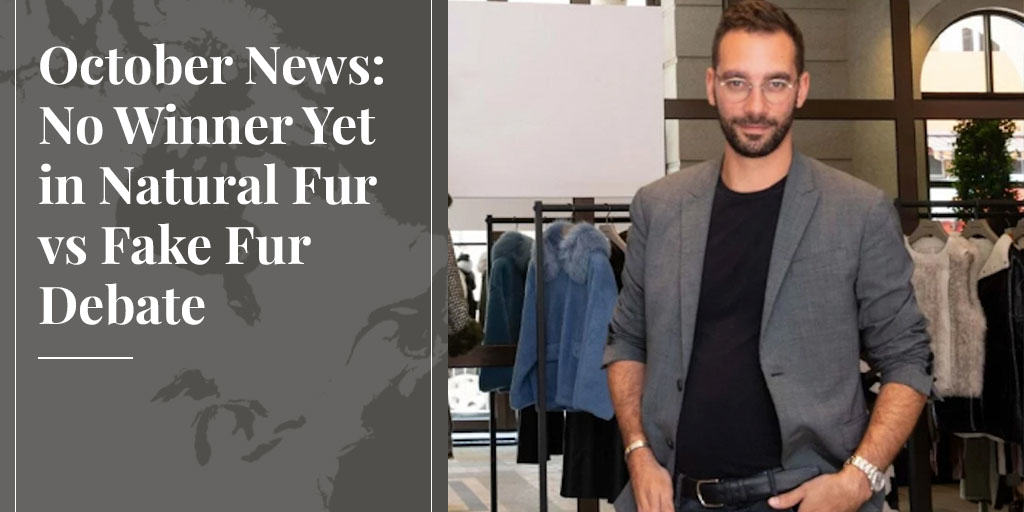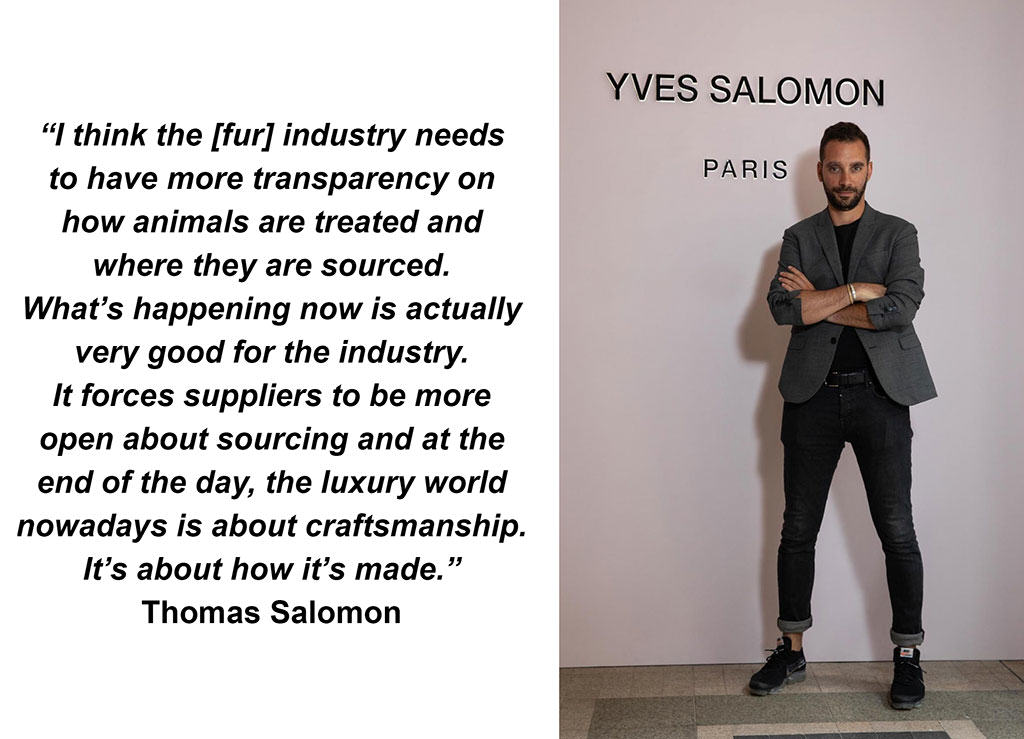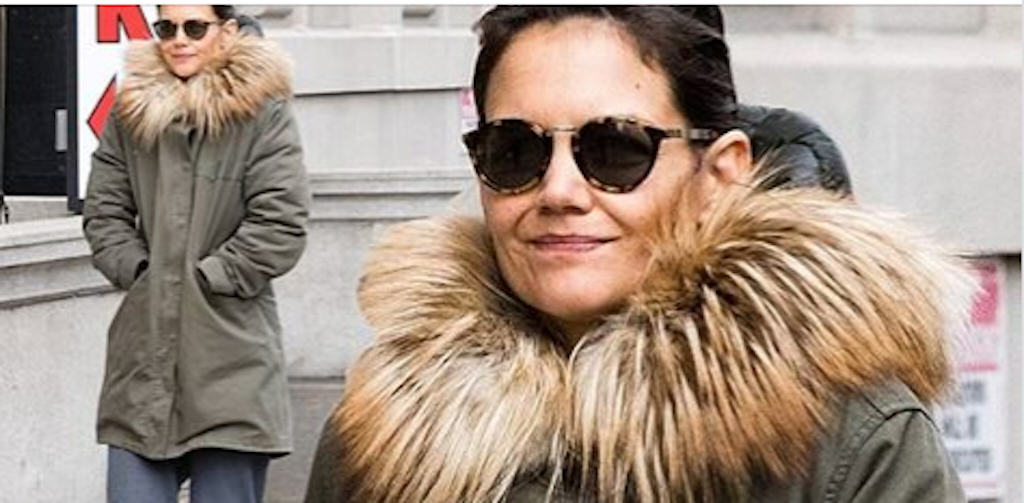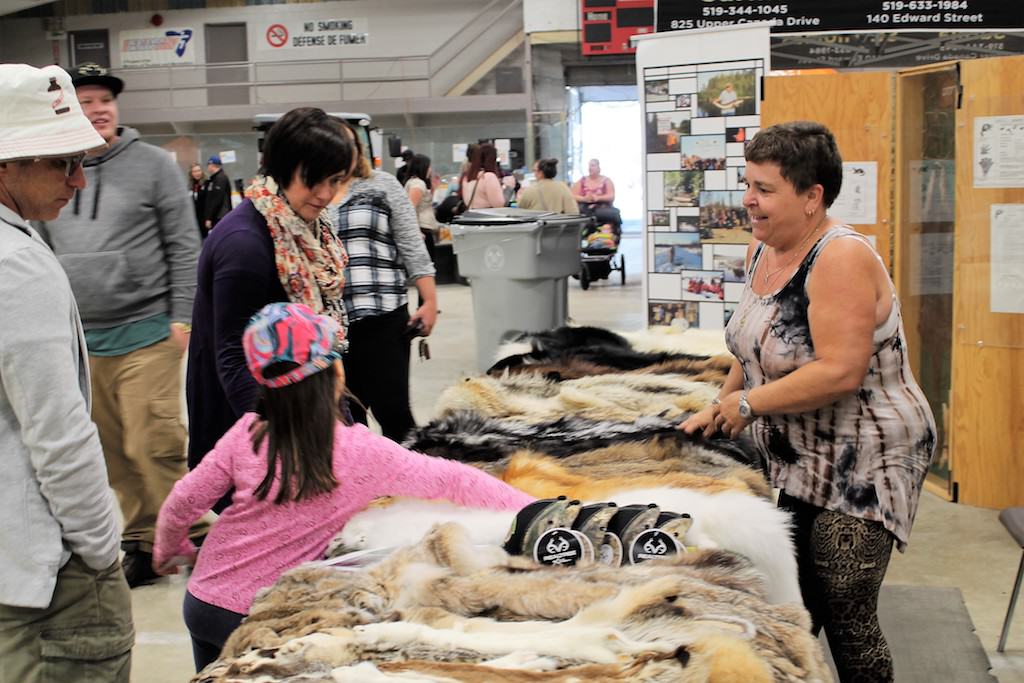
The debate over natural fur vs. fake rages on in the media, but with no new arguments being put on the table, it’s hard to tell whether our industry is gaining ground. On the upside, the sustainability argument is now front and centre, and fake fur is taking a beating, as in a recent Huffington Post piece, “Faux fur is made of plastic, and it’s not helping the environment.” On the downside, almost all media reports are using the same cute but unhelpful hook: that both natural and fake fur are bad, so what are we to do? Here’s a classic example, from Fashion United: “Fashion’s battle with fur: real vs faux”.
They call it “balanced reporting”, but there are no winners when the message getting out is that neither natural fur nor fake fur is the way to go.
But heh, let’s be optimists, like Thomas Salomon, fourth-generation owner of designer brand Yves Salomon. Thomas is a great spokesman for the fur trade as a whole, not just the retail sector, and he is adamant that the cloud now hanging over natural fur has a silver lining. When asked by Hong Kong Tatler whether fur was “a dying industry,” he responded, “It’s not a dying industry, but rather it’s a time where it’s modernising itself.”

In other fur fashion news, the Korea Herald covered last month’s Asia Remix, a contest for young designers working with fur, organised by the International Fur Federation. On hand to spread the word was Kelly Xu, CEO, IFF Asia Region. “Using fake fur damages the Earth, with the waste going to the oceans, affecting the entire ecosystem,” she said. “Fur is natural material which has been used by humans for thousands of years. It is biodegradable, it is sustainable fashion.”
Meanwhile, there’s nothing better for a designer brand than some celebrity endorsement, and guess who reaped the windfall last month? When actress Katie Holmes stepped out in Manhattan, she was wearing a snuggly fox-trimmed coat from none other than Yves Salomon. Interestingly, celebrities are in far less of a rush to ditch fur than designer brands like Gucci.

Trapping and Wildlife Management
Urban wildlife has been in the news again, and will be a regular fixture in the future. Even on the other side of the pond there’s interest in North America’s special problems, with the UK’s Guardian featuring Toronto’s raccoons. For some residents they are “scrappy heroes” but for others they are “villainous thugs”. In case you missed it, “Conrad” the raccoon achieved fame posthumously when he died on a Toronto street in 2015. During the 12 hours it took for city services to pick him up, ‘coon fans erected a memorial shrine to him.
Raccoons, of course, are a primary carrier of the rabies virus. A staggering statistic in “The value of modern day trapping” in The Bradford Era is $550 million – the cost of controlling rabies in the US annually. Without trapping, it is estimated this would balloon to $1.5 billion.
Urban coyotes are at it again, this time in Roswell, Georgia. Trapper Tim Smith was called in and soon trapped four. “They’re eating all the small dogs in the neighborhood, rabbits, every once in a while, we’ll get one that wants to come up to kids at the bus stop,” he said.
SEE ALSO: Will urban coyotes change the animal rights debate?
While North Americans argue about the place of trapping in wildlife management, New Zealanders understand. True, their eradication programs target invasive species, such as possums and rabbits, but animal rights opposition is almost unheard of. Here’s an inspiring story of one man’s efforts to protect a breeding colony of indigenous seabirds from rats, stoats, mice and hedgehogs. “Unfortunately, conservation in New Zealand is all about killing things,” says conservationist Graeme Loh. “It is grim. I’ve been involved in the biodiversity part of things for many years, and most of my work has been working out better ways to kill more of the right stuffs at the right time.”
SEE ALSO: New Zealand designer embraces wild rabbit “eco-fur”.

Education, of course, is the key, which is why the Timmins Fur Council in Ontario takes its outreach programs to kids and families very seriously. Read “Put down your gadgets kids, learn to love nature” by council member Kaileigh Russell. If the name sounds familiar, that’s because the council was co-founded by her grandfather fully 50 years ago.
Last but by no means least (especially if you’re a Brit yearning to live in the past), learn about a traditional form of wildlife management that’s making a comeback: molecatching. “Moleskin: A unique fur once favoured by British high society” is a story of royalty, a pest, and a unique fur that takes 600 pelts to make one coat!











Hello,
my name is Alex ( from germany))
I defenetly say that the fake fur stuff is not good for the enviroment and the humans.
its plastic, that is geting produced with a huge amount of chemicals. and wen its old and thrown awy it will not rott.Just like a plasticbag.
Real fur is far better, it keeps us warmer then the plastic fake fur. it alows the skin to breath. it looks better. its healthyer then the plastic fake fur, not just for humans so for the enviroment.
and if you throw it away it will rott within some years or even faster.
so the only thing we can do, is to buy real fur. check were it comes from. dont buy cheep stuff. quality!!! That meens to buy the fur at the furrier in youre area .
thats my meaning about that topic!
LG Alex
Hi Alex, I absolutely agree with you. I’ve already done what you say (and I’m gonna do it in future!): I own a fox fur coat and some other fur garments and it is real fur only. I started with a lamb fur boots – and I was decided instantly! It is incomparable to any faux “fur”, which can maybe imitate the outlook, but the qualities are totaly different. How you say, real fur breaths, it is natural, soft.., each fur animals has its own fur qualities, which you feel in the fur on you – that is impossible to imitate artificially. The difference is the same as considering leather – who would like to wear faux leather shoes? Wearing faux fur, I would shy, if somebody asked me: “Is it real?” I don’t mind animals killed for fur since I eat meat and wear leather – humans are predators and no animal realises, whether it dies for our meal our for our clothing:). And how it was written here, fur trapping is useful for the wildlife management: a lot of furbearers are pests, for example the reduction of beavers prevents dam damages. So I am a big fan of this blog, because here are great articles and it puts true facts against the stupid emotional “animal lovers’ ” propaganda. Btw. the last sentence of the article about the moles has made me laugh: That would be a titbit for each PETA follower! 🙂